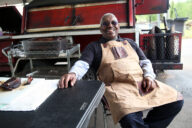
Article and photography by Joshua Fitzwater
Lead photo: Family photograph of the Turner Ham house being constructed
Family, history, and time – these three variables often seem to reside in the best of Virginia food. Barbecue, Brunswick stew, and American-style macaroni and cheese, just to name a few Virginia dishes, not only predate all other American versions, but are tied in their creation to these three characteristics. Over time, the rest of the states took from these Virginian food stables in direct and indirect ways when creating their own renditions, and ultimately the establishment of what we know today as American cuisine was born. Virginia cured hams are no exception, and some of the best are being done just a few miles from the West Virginian border in the Shenandoah Valley at Fulks Run Grocery, home of Turner Hams.

Turner Ham’s owner Ron Turner in the ham house
Today, when you talk of cured hams, by numbers anyway, more people still tend to think of the Tidewater region of Virginia and its famous salt cured hams from Smithfield hams, Edwards hams, Darden hams and others loom largely in the Virginian psyche. Unfortunately, however, Smithfield ham was bought out by Chinese interests some years ago, and American owned Edwards of Surry was dealt a serious blow a few years ago when its prestigious smokehouse and operation caught fire and burned to the ground, which caused some reshuffling. In addition to the issues that affected Edwards and Smithfield hams, it has become cheaper to purchase mass produced hams, which are often of low quality, and the result is fewer quality, handcrafted cured hams made in Virginia end up in Virginia kitchens. This only further emphasizes the importance of Turner Hams to the state.

Sliced sugar cured Turner Ham sandwich
Though curing meats goes back a bare minimum of 5,000 plus years, as sales manager and Edwards Virginia Smokehouse’s “Ham Evangelist”, Keith Roberts explains, “early Virginians, using traditional English techniques, paired that with the addition of hickory smoke, following the approach of the Native Americans, to create Virginia country ham.” As Roberts further explains, “curing ham early on was about survival. You can trace it back to the Jamestown settlement. In terms of the Smithfield area, sales of cured hams can be traced back to the town in the 1700s with even earlier sales of cured hams being sold out of the country from Surry County in the 1600s.”
——————————————————————————————————–

Select back issues of Southern Grit Magazine are available for purchase in limited numbers at the following link southerngritmagazine.bigcartel.com
——————————————————————————————————–
While the Tidewater region’s reputation rests in the salt cured lane, the incorporation of sugar in the cure also plays a part in defining Virginia hams. “Though there are different schools of thought pertaining to the incorporation of sugar into hams, in large part sweet hams can be traced back to the 1920s both for taste purposes and color reasons which result from the addition of brown sugar,” said Roberts.
The 1920’s timeline Roberts points to in regards to sugar cures, lines up right with the story behind Turner Hams. As Ron Turner, owner of Turner Hams, explains while walking to his smokehouse behind Fulks Run Grocery on an unusually brisk day in April, “all of this begins with my great-grandfather’s cure recipe which dates back to the early ‘20s. It’s local to Fulks Run. It’s always been sugar cured. I believe it’s a regional thing. I only know one person who uses pure salt.”

Turner Hams and Fulks Run Grocery storefront
Ron’s father, Garnett Turner, who would build the ham house in 1966, first began curing hams with his father Webster Turner’s cure recipe for personal use. As Ron detailed, “the first year he cured 25 and sold them out of the store immediately. The next year he sold 75. Then the following year 300. Then he built the ham house where 1,000 to 1,500 could be cured.”
In 1969, Ron’s father Garnett sold the grocery to his brother Miles Marcella, although Garnett retained ownership of the ham house, and Garnett’s immediate family was always central to the business. As Ron recalled with a slight smile, “all of my sisters and I grew up working with dad. If we were old enough to lift something then we were old enough to work.”

Peggie Turner and the Ham Van
After his childhood, Ron completed a Bachelors in Fine Art, and became a photographer upon moving to Washington, D.C. In 1991, however, Ron returned to Fulks Run with his wife Peggie and ran the ham house exclusively until 1996 when the couple purchased back the grocery. “The two go hand in hand,” Ron explained.

Above, Clockwise: A curing Turner Ham in the ham house and sugar cured Turner Ham sliced and weighed at Fulks Run Grocery
Since then, Ron and Peggie have dedicated themselves to preserving the Turner Ham legacy Webster and Garnett established, which requires as much time as it does skill, all while simultaneously expanding the family grocery, but with care in order to not sacrifice the original charm that dates back to its inception in 1949. It’s this commitment to honoring time, family and history that makes Fulks Run Grocery and Turner Hams one of the most beloved and important foodways institutions in Virginia.

Fulks Run Grocery store decor
For more on Fulks Run Grocery and Turner Hams, visit fulksrungrocery.com







No Comments